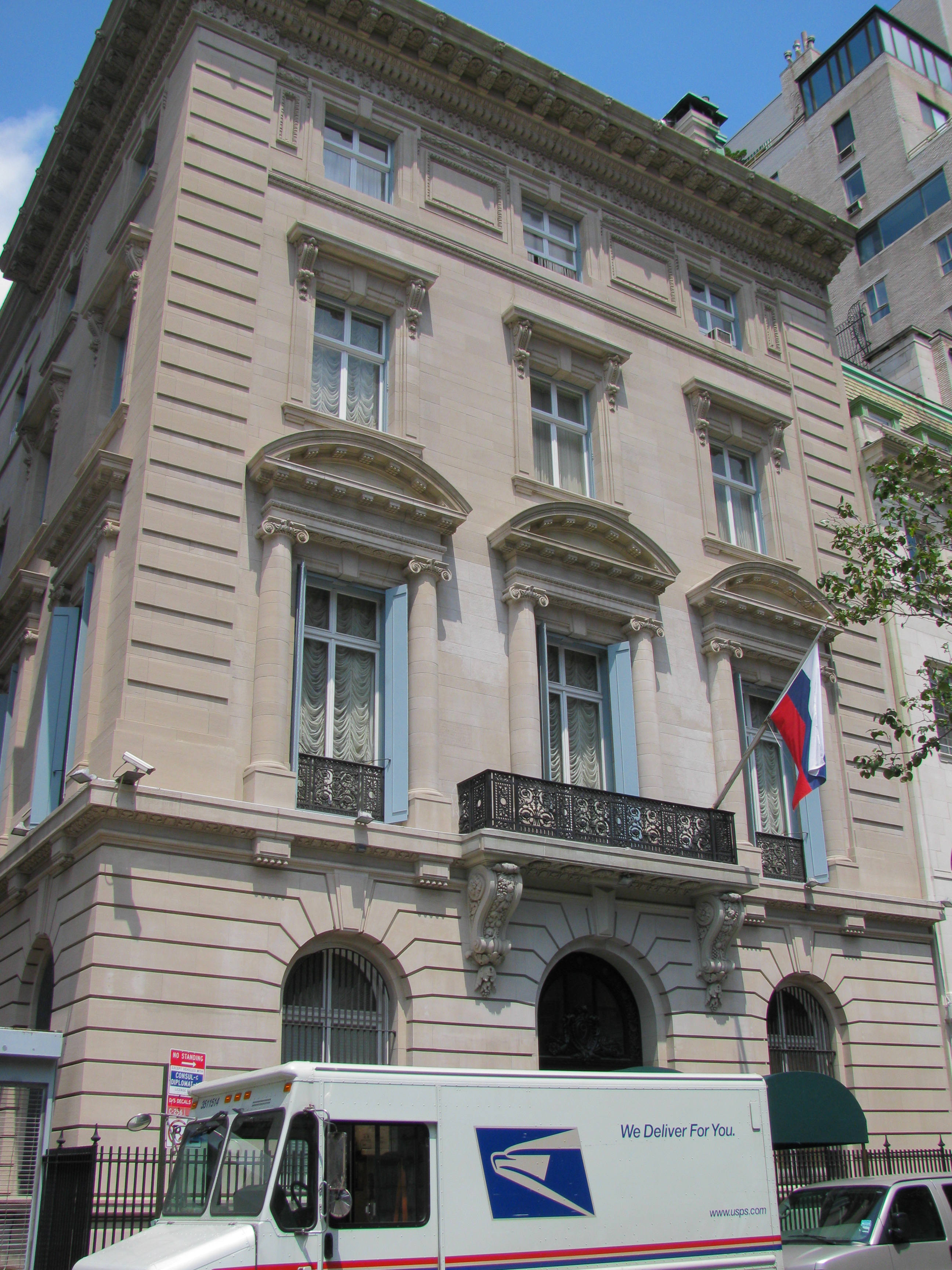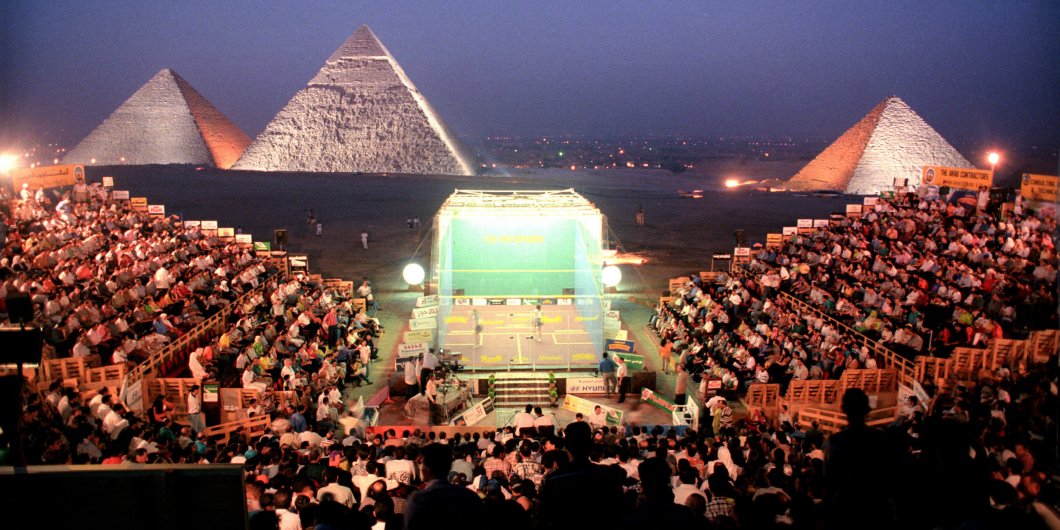|
Hammond House (New York, New York)
The John Henry Hammond House is a mansion at 9 East 91st Street on the Upper East Side in New York City. Since October 26, 1994 the Consulate General of Russia in New York City has been located there. Site The purchase of land fronting on Fifth Avenue between 90th and 91st Streets by Andrew Carnegie, and the 1901 building of his mansion (which now houses the Cooper-Hewitt Museum), saw Carnegie buy neighboring building lots in order to protect his investment. The entire north side of 91st Street between Fifth and Madison Avenues was purchased by Carnegie. Carnegie sold off lots to individuals who agreed to build substantial dwellings, and in 1903, a home was built at 9 East 91st Street by John H. Hammond, a New York City banker. The land, and possibly the house, was a wedding gift to Hammond and his wife ( Emily Vanderbilt Sloane) from her father, William Douglas Sloane of the firm W. & J. Sloane. Architecture The five-story Renaissance style town house was designed by Carrà ... [...More Info...] [...Related Items...] OR: [Wikipedia] [Google] [Baidu] |
Consulate-General Of Russia In New York City
The Consulate General of Russia in New York City is the diplomatic mission of the Russian Federation in New York City. Opened in 1994, the consulate is located at 9 East 91st Street in the former John Henry Hammond House on the Upper East Side of Manhattan. A consulate of the former Soviet Union had previously existed on East 61st Street from 1933 until 1948. The house The house was built in 1903 by John H. Hammond, a New York City banker. The five-story Renaissance style limestone townhouse was designed by Carrère and Hastings, who were also responsible for the design of the New York Public Library Main Branch, and is regarded as one of their finest residences. The ground floor has pronounced banded Rustication (architecture), rustication, while the other floors contain progressively smaller windows. 1933â1948 In 1933 the United States extended diplomatic recognition to the Soviet Union, and on 21 April 1934 the Soviets opened a consulate general in New York City at 7â9 Eas ... [...More Info...] [...Related Items...] OR: [Wikipedia] [Google] [Baidu] |
Palazzo
A palace is a large residence, often serving as a royal residence or the home for a head of state or another high-ranking dignitary, such as a bishop or archbishop. The word is derived from the Latin name palÄtium, for Palatine Hill in Rome which housed the Roman Empire, Imperial residences. Most European languages have a version of the term (''palats'', ''palais'', ''palazzo'', ''palacio'', etc.) and many use it to describe a broader range of buildings than English. In many parts of Europe, the equivalent term is also applied to large private houses in cities, especially of the aristocracy. It is also used for some large official buildings that have never had a residential function; for example in French-speaking countries ''Palais de Justice'' is the usual name of important courthouses. Many historic palaces such as parliaments, museums, hotels, or office buildings are now put to other uses. The word is also sometimes used to describe an elaborate building used for public ent ... [...More Info...] [...Related Items...] OR: [Wikipedia] [Google] [Baidu] |
Ballroom
A ballroom or ballhall is a large room inside a building, the primary purpose of which is holding large formal parties called ''balls''. Traditionally, most balls were held in private residences; many mansions and palaces, especially historic mansions and palaces, contain one or more ballrooms. In other large houses, a large room such as the main drawing room, long gallery, or hall may double as a ballroom, but, a good ballroom should have the right type of flooring, such as hardwood flooring or stone flooring (usually marble or stone).. For most styles of modern dance, a wooden sprung floor offers the best surface. In later times the term ballroom has been used to describe nightclubs where customers dance, the Top Rank Suites in the United Kingdom for example were also often referred to as ballrooms. The phrase "having a ball" has grown to encompass many events where person(s) are having fun, not just dancing. Ballrooms are generally quite large, and may have ceilings ... [...More Info...] [...Related Items...] OR: [Wikipedia] [Google] [Baidu] |
Roller Skating
Roller skating is the act of travelling on surfaces with roller skates. It is a recreation, recreational activity, a sport, and a form of transportation. Roller rinks and skate parks are built for roller skating, though it also takes place on streets, sidewalks, and bike paths. Roller skating originated in the performing arts in the 18th century. It gained widespread popularity starting in the 1880s. Roller skating was very popular in the United States from the 1930s to the 1950s, then again in the 1970s when it was associated with Disco, disco music and roller discos. During the 1990s, inline skates, inline outdoor roller skating became popular. Roller skating has often been a part of Black people, Black and LGBT history in particular. Sport roller skating includes Inline speed skating, speed skating, roller hockey, roller derby, Artistic roller skating, figure skating and aggressive quad skating. History The earliest roller skates known are from 18th-century Europe. These ... [...More Info...] [...Related Items...] OR: [Wikipedia] [Google] [Baidu] |
Squash Court
Squash, sometimes called squash rackets, is a racket sport played by two (singles) or four players (doubles) in a four-walled court with a small, hollow, rubber ball. The players alternate striking the ball with their rackets, directing it onto the playable surfaces of the four walls of the court. The object of the game is to hit the ball in such a way that the opponent is not able to play a valid return. There are about 20 million people who play squash regularly worldwide in over 185 countries. The governing body of squash, the World Squash Federation (WSF), is recognized by the International Olympic Committee (IOC), and the sport will be included in the Olympic Games, starting with the 2028 Summer Olympics in Los Angeles. The Professional Squash Association (PSA) organizes the pro tour. History Squash has its origins in the older game of rackets, which was played in London's prisons in the 19th century. Later, around 1830, boys at Harrow School noticed that a punctured bal ... [...More Info...] [...Related Items...] OR: [Wikipedia] [Google] [Baidu] |
Louis XVI
Louis XVI (Louis-Auguste; ; 23 August 1754 â 21 January 1793) was the last king of France before the fall of the monarchy during the French Revolution. The son of Louis, Dauphin of France (1729â1765), Louis, Dauphin of France (son and heir-apparent of Louis XV, King Louis XV), and Maria Josepha of Saxony, Dauphine of France, Maria Josepha of Saxony, Louis became the new Dauphin of France, Dauphin when his father died in 1765. In 1770, he married Marie Antoinette. He became King of France and Navarre on his grandfather's death on 10 May 1774, and reigned until the proclamation of the abolition of the monarchy, abolition of the monarchy on 21 September 1792. From 1791 onwards, he used the style of king of the French. The first part of Louis XVI's reign was marked by attempts to reform the French government in accordance with Enlightened absolutism, Enlightenment ideas. These included efforts to increase Edict of Versailles, tolerance toward non-Catholics as well as abolishing ... [...More Info...] [...Related Items...] OR: [Wikipedia] [Google] [Baidu] |
Entablature
An entablature (; nativization of Italian , from "in" and "table") is the superstructure of moldings and bands which lies horizontally above columns, resting on their capitals. Entablatures are major elements of classical architecture, and are commonly divided into the architrave (the supporting member immediately above; equivalent to the lintel in post and lintel construction), the frieze (an unmolded strip that may or may not be ornamented), and the cornice (the projecting member below the pediment). The Greek and Roman temples are believed to be based on wooden structures, the design transition from wooden to stone structures being called petrification. Overview The structure of an entablature varies with the orders of architecture. In each order, the proportions of the subdivisions (architrave, frieze, cornice) are defined by the proportions of the column. In Roman and Renaissance interpretations, it is usually approximately a quarter of the height of the column. Va ... [...More Info...] [...Related Items...] OR: [Wikipedia] [Google] [Baidu] |
Corbel
In architecture, a corbel is a structural piece of stone, wood or metal keyed into and projecting from a wall to carry a wikt:superincumbent, bearing weight, a type of bracket (architecture), bracket. A corbel is a solid piece of material in the wall, whereas a console is a piece applied to the structure. A piece of timber projecting in the same way was called a "tassel" or a "bragger" in England. The technique of corbelling, where rows of corbels deeply keyed inside a wall support a projecting wall or parapet, has been used since Neolithic (New Stone Age) times. It is common in medieval architecture and in the Scottish baronial style as well as in the vocabulary of classical architecture, such as the modillions of a Corinthian order, Corinthian cornice. The corbel arch and corbel vault use the technique systematically to make openings in walls and to form ceilings. These are found in the early architecture of most cultures, from Eurasia to Pre-Columbian architecture. A conso ... [...More Info...] [...Related Items...] OR: [Wikipedia] [Google] [Baidu] |
Ionic Order
The Ionic order is one of the three canonic classical order, orders of classical architecture, the other two being the Doric order, Doric and the Corinthian order, Corinthian. There are two lesser orders: the Tuscan order, Tuscan (a plainer Doric), and the rich variant of Corinthian called the composite order. Of the three classical canonic orders, the Corinthian order has the narrowest columns, followed by the Ionic order, with the Doric order having the widest columns. The Ionic capital is characterized by the use of volutes. Ionic columns normally stand on a base which separates the shaft of the column from the stylobate or platform while the cap is usually enriched with egg-and-dart. The ancient architect and architectural historian Vitruvius associates the Ionic with feminine proportions (the Doric representing the masculine). Description Capital The major features of the Ionic order are the volutes of its capital (architecture), capital, which have been the subject of mu ... [...More Info...] [...Related Items...] OR: [Wikipedia] [Google] [Baidu] |
Pediment
Pediments are a form of gable in classical architecture, usually of a triangular shape. Pediments are placed above the horizontal structure of the cornice (an elaborated lintel), or entablature if supported by columns.Summerson, 130 In ancient architecture, a wide and low triangular pediment (the side angles 12.5° to 16°) typically formed the top element of the portico of a Greek temple, a style continued in Roman temples. But large pediments were rare on other types of building before Renaissance architecture. For symmetric designs, it provides a center point and is often used to add grandness to entrances. The cornice continues round the top of the pediment, as well as below it; the rising sides are often called the "raking cornice". The tympanum is the triangular area within the pediment, which is often decorated with a pedimental sculpture which may be freestanding or a relief sculpture. The tympanum may hold an inscription, or in modern times, a clock face. ... [...More Info...] [...Related Items...] OR: [Wikipedia] [Google] [Baidu] |
Aedicula
In religion in ancient Rome, ancient Roman religion, an ''aedicula'' (: ''aediculae'') is a small shrine, and in classical architecture refers to a Niche (architecture), niche covered by a pediment or entablature supported by a pair of columns and typically framing a statue,"aedicula, n." ''OED Online'', Oxford University Press, September 2020www.oed.com/view/Entry/3077 Accessed 29 September 2020."aedicule, n." ''OED Online'', Oxford University Press, September 2020www.oed.com/view/Entry/3079 Accessed 29 September 2020 the early Christian ones sometimes contained funeral urns. ''Aediculae'' are also represented in art as a form of ornamentation. The word ''aedicula'' is the diminutive of the Latin ''aedes (Roman), aedes'', a temple building or dwelling place. The Latin word has been Anglicisation of names, anglicised as "aedicule" and as "edicule". Describing post-antique architecture, especially Renaissance architecture, aedicular forms may be described using the word tabernacle ... [...More Info...] [...Related Items...] OR: [Wikipedia] [Google] [Baidu] |
Piano Nobile
( Italian for "noble floor" or "noble level", also sometimes referred to by the corresponding French term, ) is the architectural term for the principal floor of a '' palazzo''. This floor contains the main reception and bedrooms of the house. The German term is (meaning "beautiful storey", from the French ). Both date to the 17th century. Characteristics The ''piano nobile'' is usually the first floor (in European terminology; second floor in American terms) or sometimes the second storey and contains major rooms, located above the rusticated ground floor containing the minor rooms and service rooms. The reasons were so that the rooms above the ground floor would have finer views and to avoid the dampness and odours of the street level. That is especially true in Venice, where the ''piano nobile'' of the many '' palazzi'' is especially obvious from the exterior by virtue of its larger windows and balconies and open loggias. Examples are Ca' Foscari, Ca' d'Oro, Ca' Vend ... [...More Info...] [...Related Items...] OR: [Wikipedia] [Google] [Baidu] |







